Cooling Effect of Rivers on Metropolitan Taipei Using Remote Sensing
Abstract
:1. Introduction
2. Method
2.1. Land Surface Temperature and Ground Emissivity Using Landsat 7 Data



 :
:

 , and also the one from the surface of the Earth that passes through the atmosphere. Via atmospheric correction,
, and also the one from the surface of the Earth that passes through the atmosphere. Via atmospheric correction,  can be expressed by the long wave emissivity of the Earth’s surface, L↑:
can be expressed by the long wave emissivity of the Earth’s surface, L↑:

 , and also the surface radiation,
, and also the surface radiation,  , the equation can be written as:
, the equation can be written as:


 remains as Equation (4). Due to lack of radiosonde data for the area studied, it is simply assumed surface radiation,
remains as Equation (4). Due to lack of radiosonde data for the area studied, it is simply assumed surface radiation,  , equals the radiation on the top of the atmosphere,
, equals the radiation on the top of the atmosphere,  . Thus, the land surface temperature, T0, can be found by Equation (9):
. Thus, the land surface temperature, T0, can be found by Equation (9):


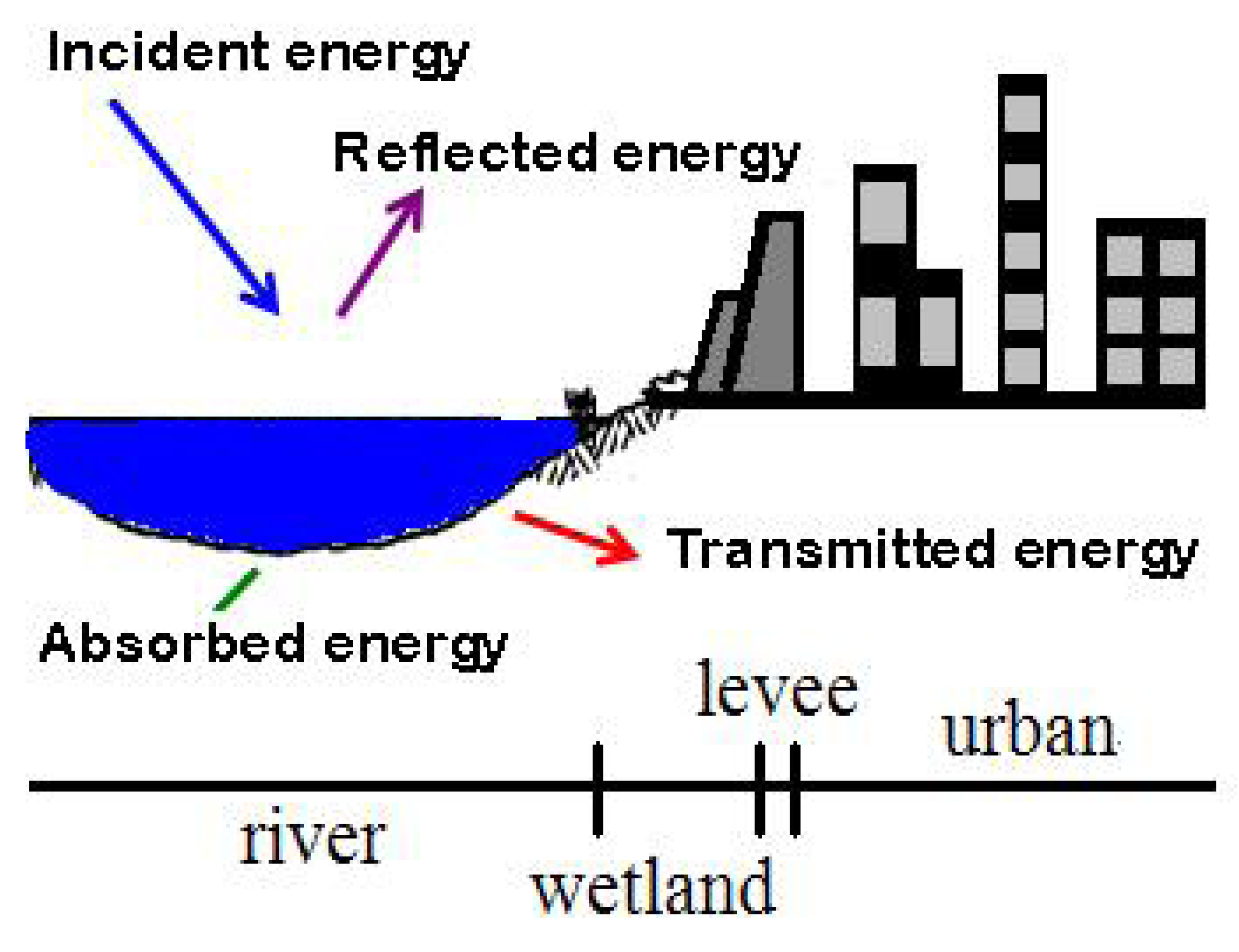
2.2. Land Use Classification Using Formosat-2 Data
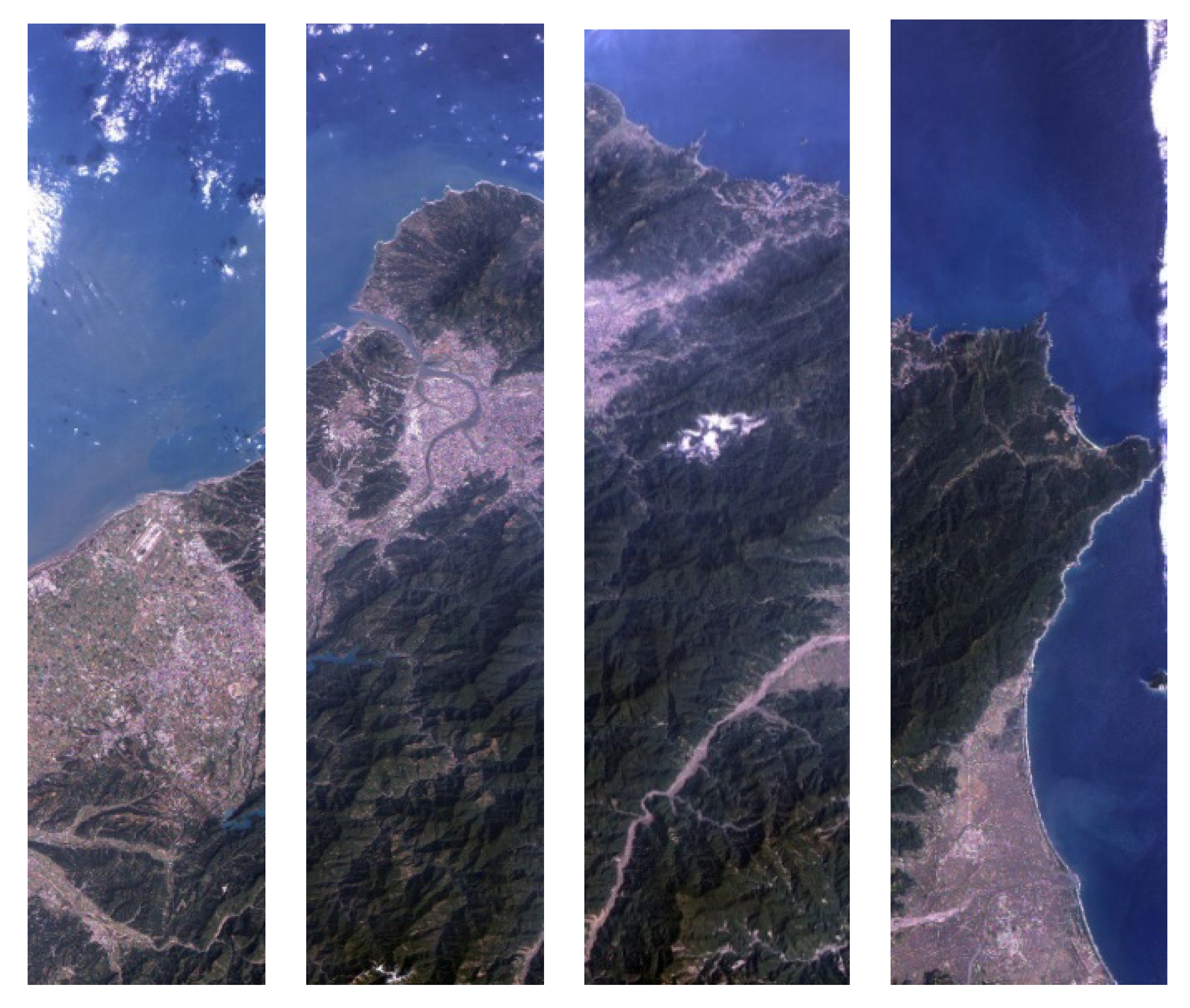
2.3. Study Area Description
| Observation | ||||||||
|---|---|---|---|---|---|---|---|---|
| Estimation | Water | Bare soil | Construction | Herbal | Plant | Total Pixel | User Accuracy (%) | |
| Water | 24 | 0 | 0 | 0 | 0 | 24 | 100 | |
| Bare soil | 0 | 47 | 5 | 2 | 4 | 58 | 81 | |
| Construction | 1 | 3 | 45 | 0 | 0 | 49 | 92 | |
| Herbal | 0 | 8 | 7 | 34 | 0 | 49 | 69 | |
| Plant | 0 | 0 | 0 | 0 | 79 | 79 | 100 | |
| total pixel | 25 | 58 | 57 | 36 | 83 | 259 | overall accuracy = 88.4% | |
| Producer Accuracy (%) | 96 | 81 | 79 | 94 | 95 | Kappa = 0.85 | ||
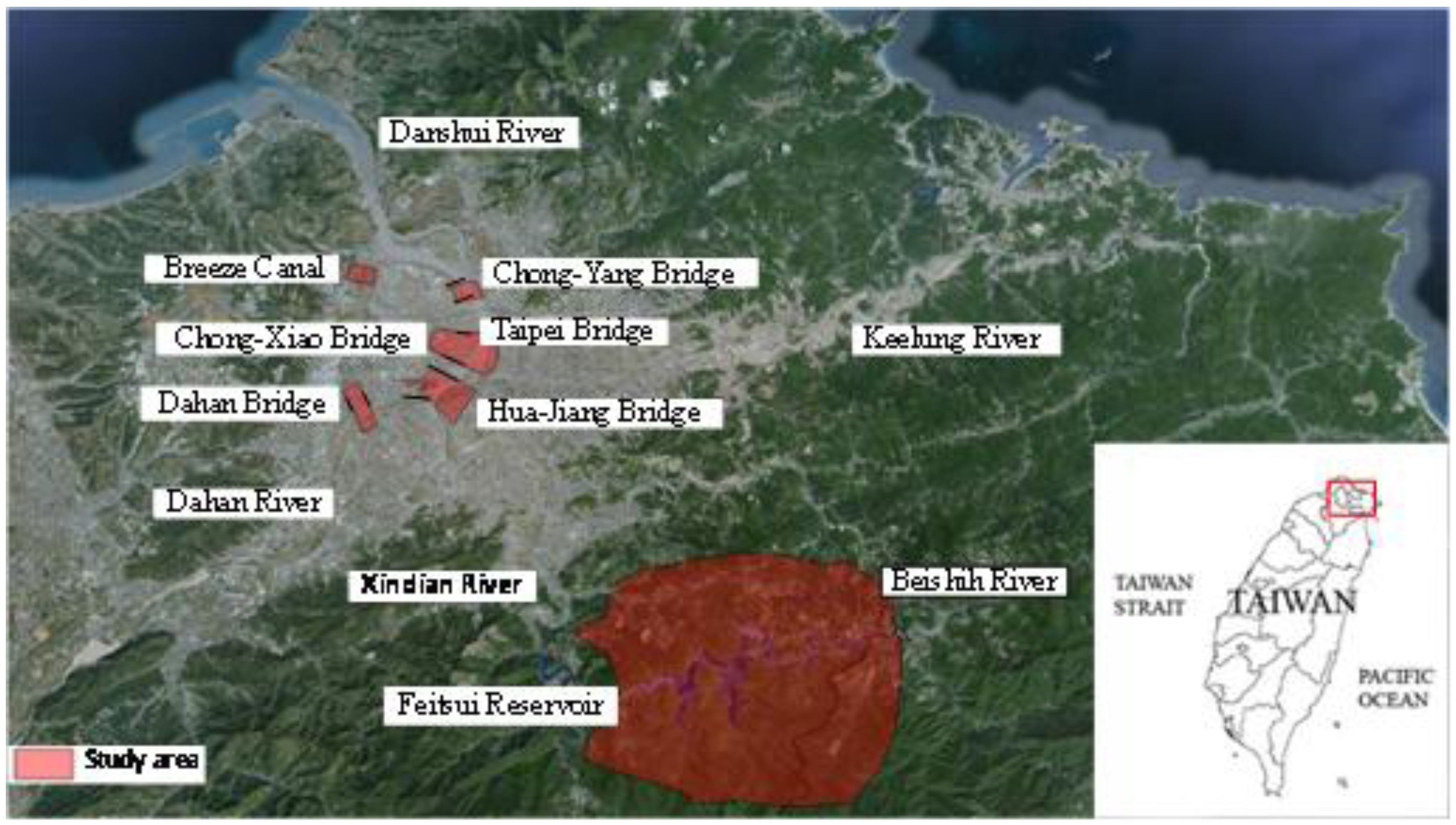
3. Results and Discussion
3.1. Research and Analysis of Surface Temperature
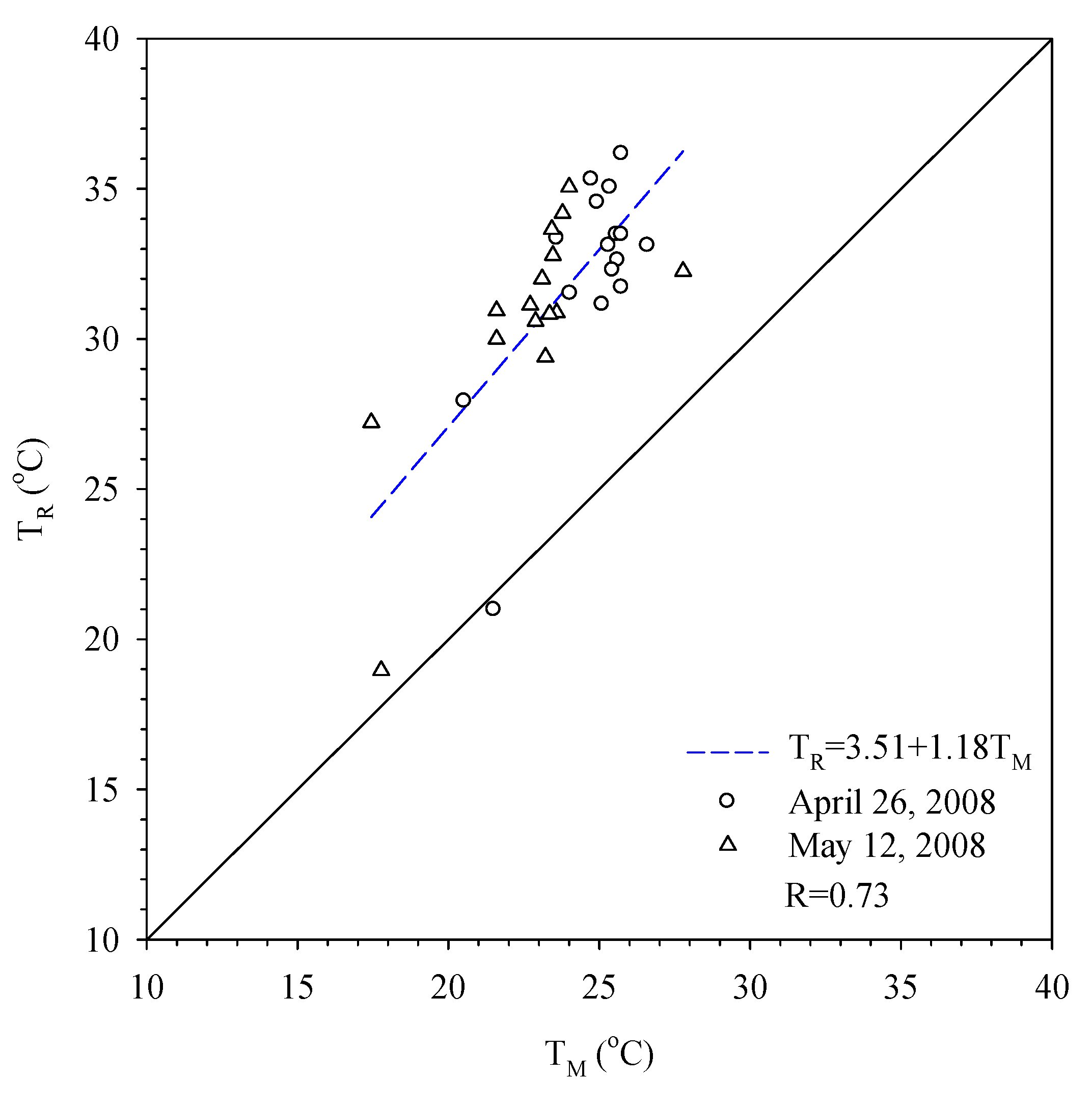
3.2. Cooling Effect of Rivers on the Natural Area

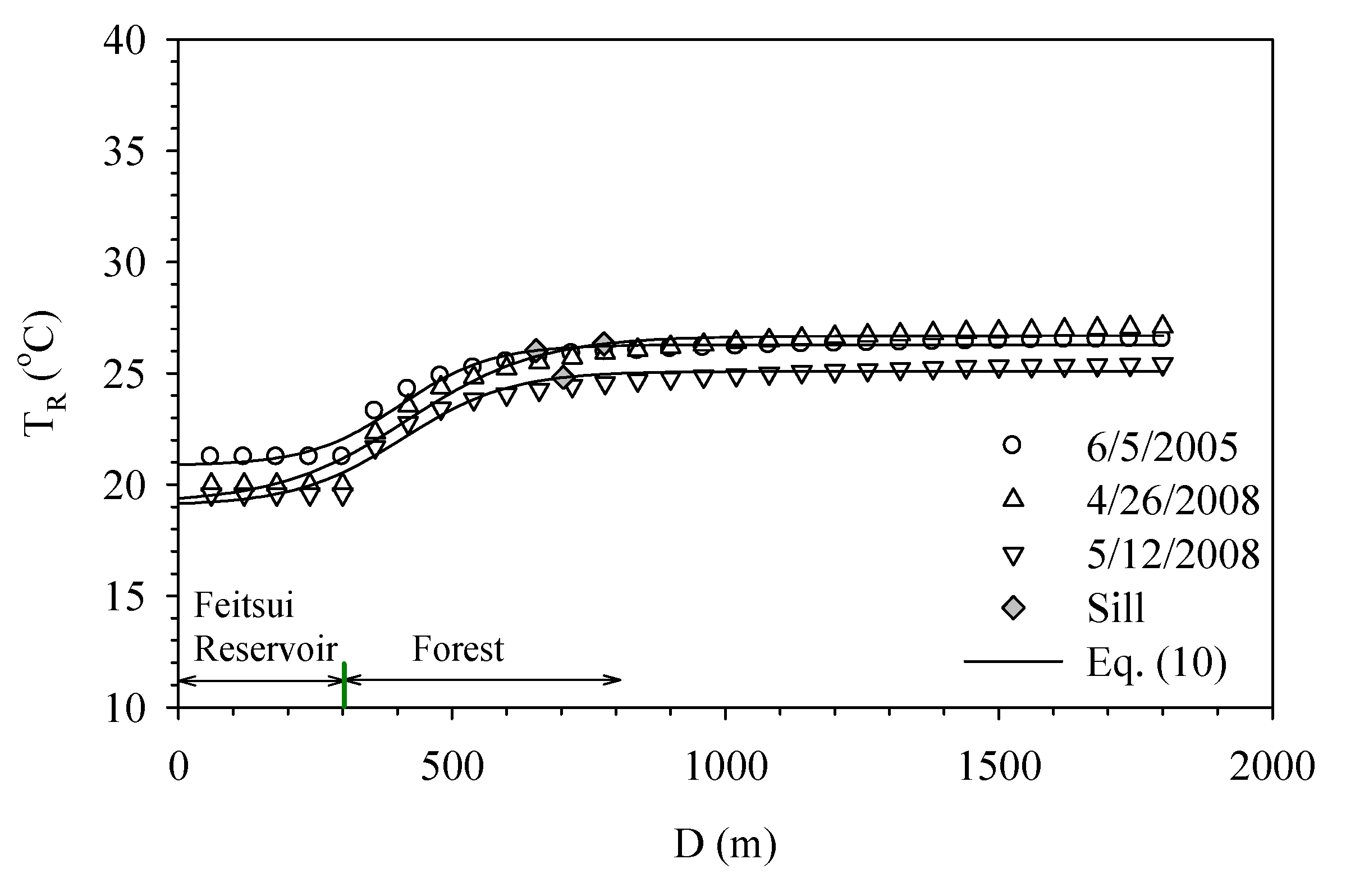
3.3. Cooling Effect of River on the Urban Area
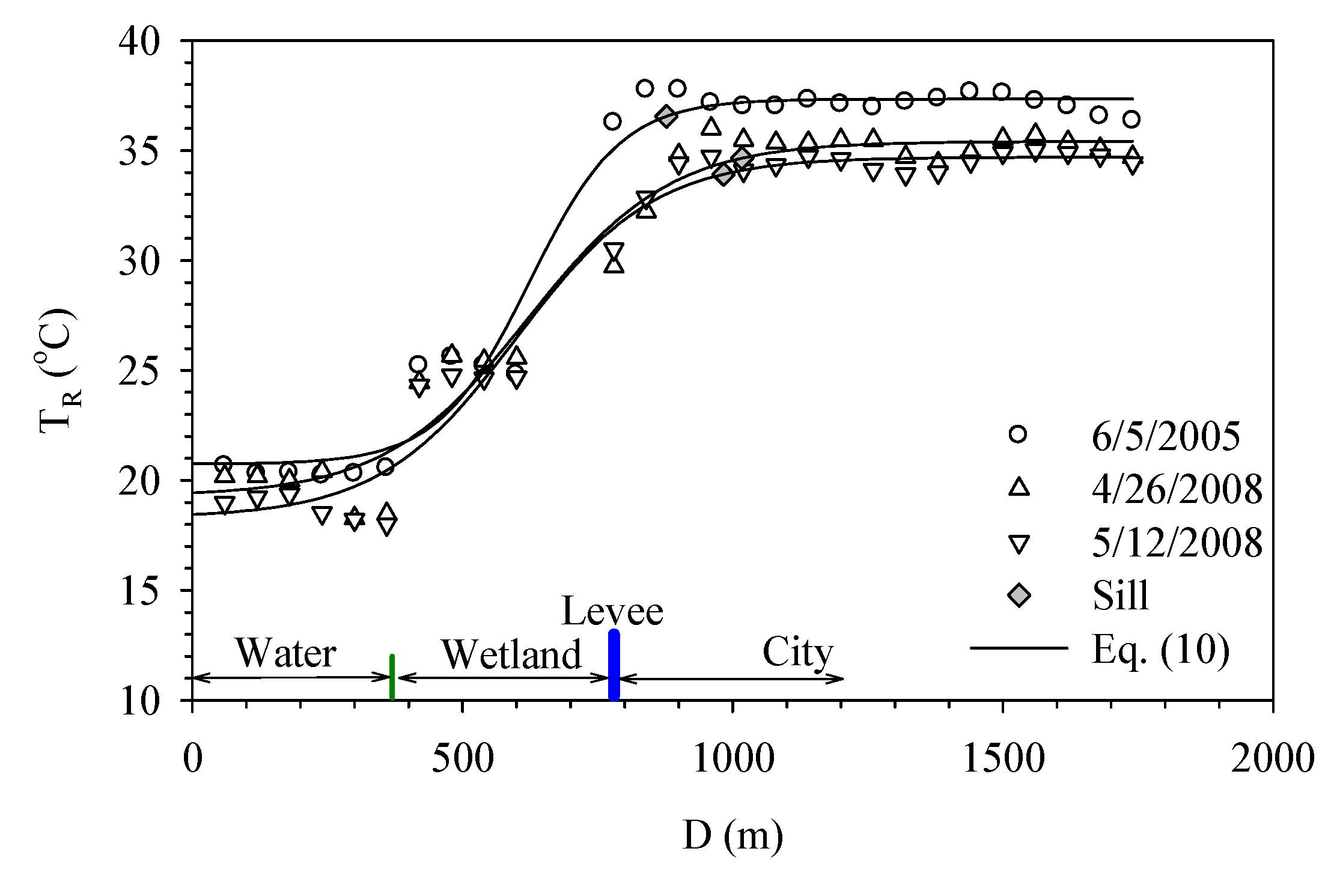
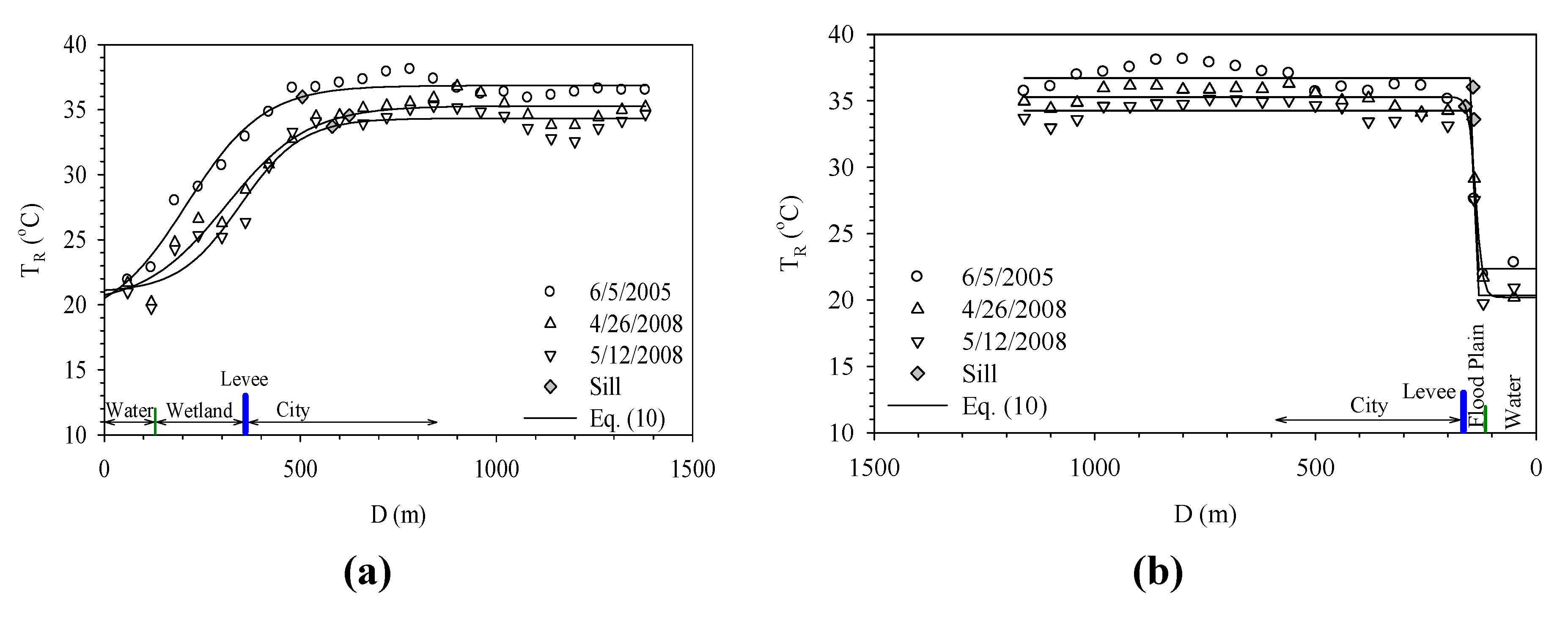
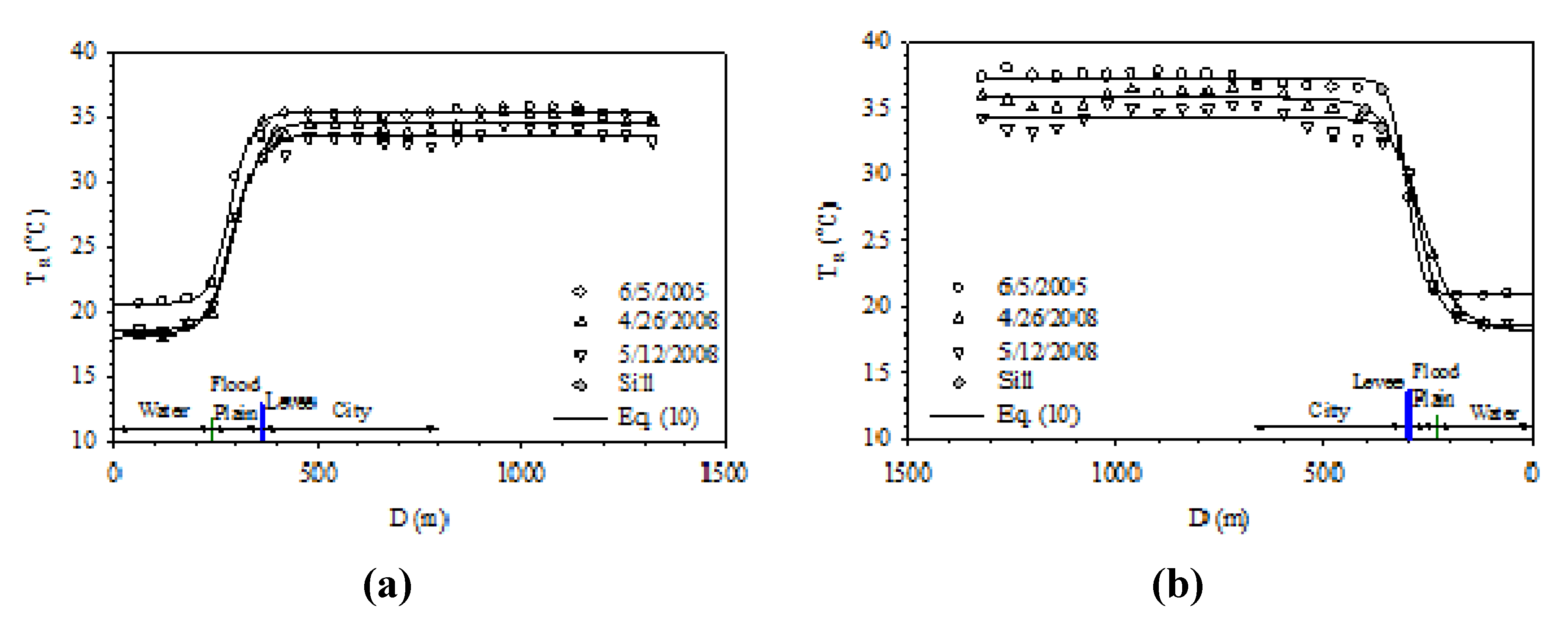
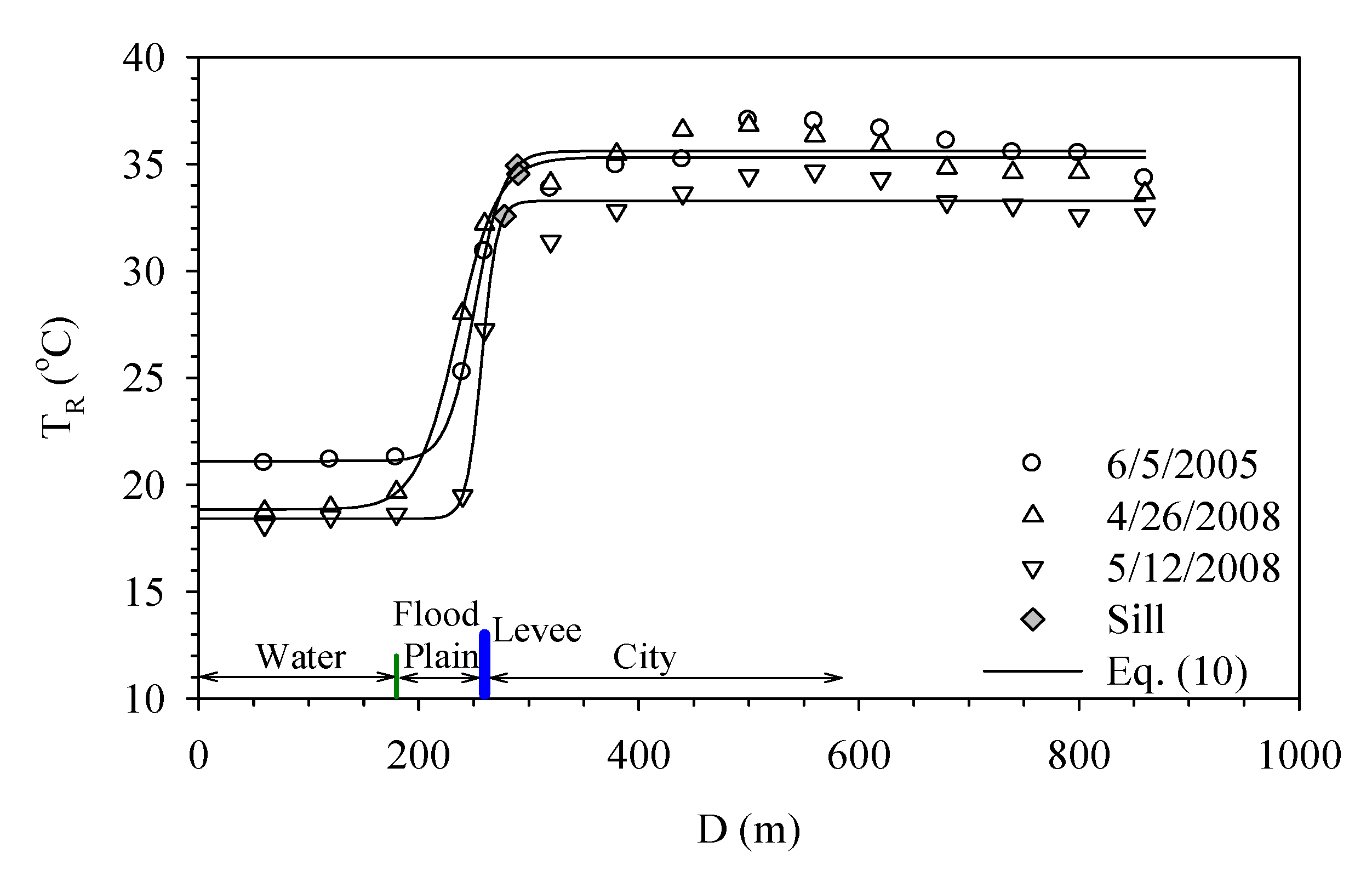
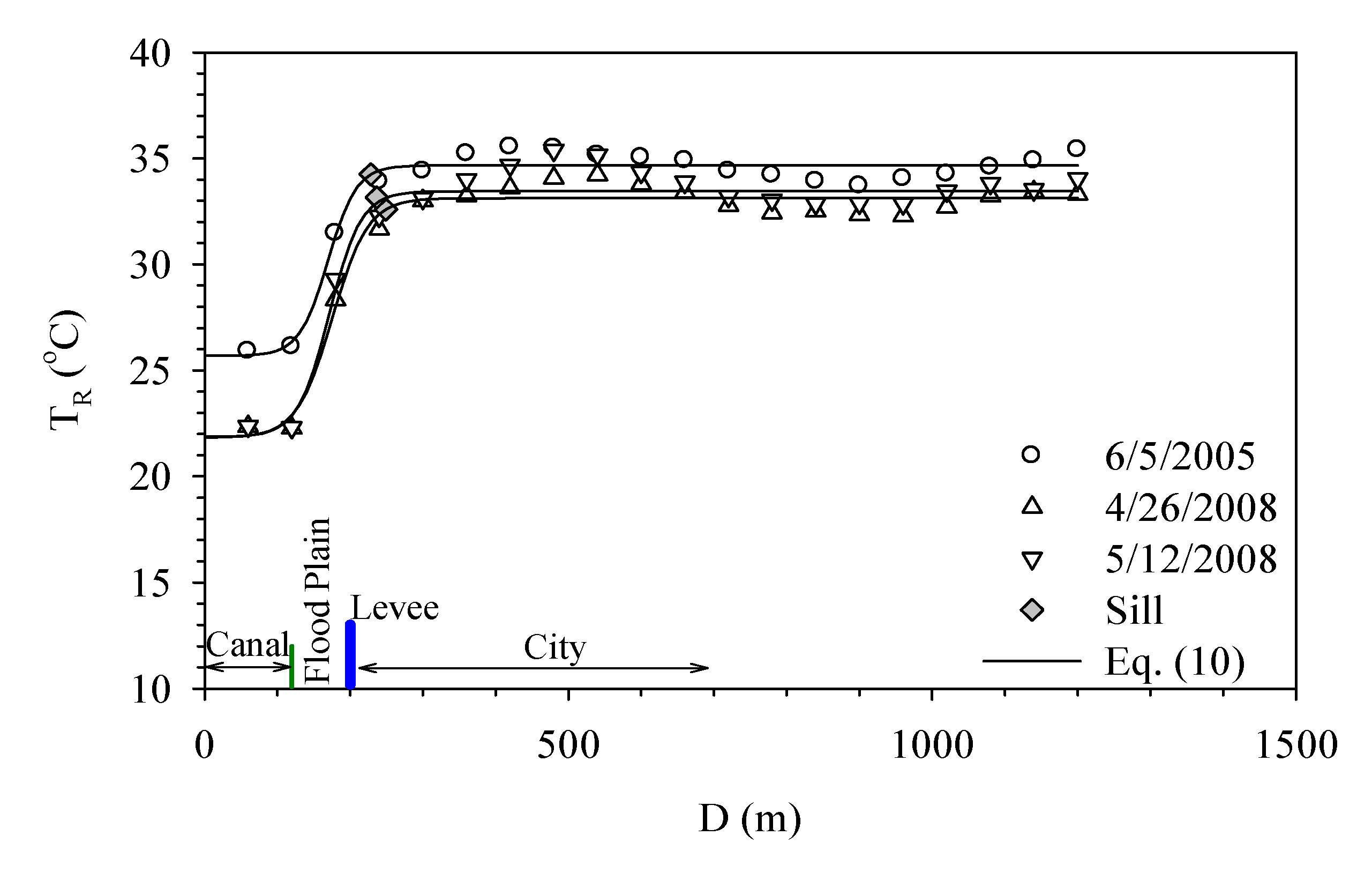
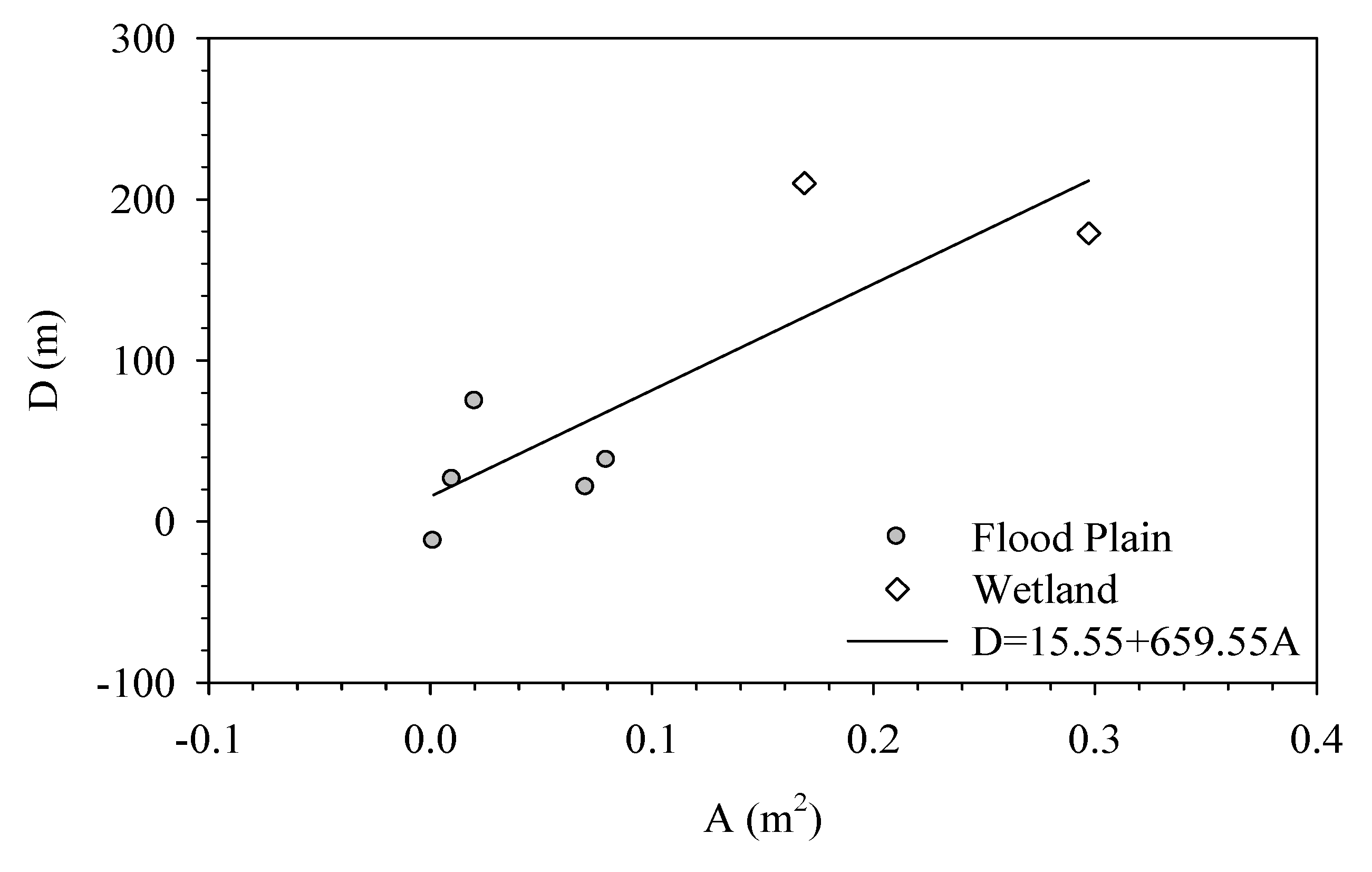
| Location | Date | Average Channel width (m) | Average Width of Wetland (m) | Average Width of Flood Plain (m) | Influence Distance (m) | Average Influence Distance (m) |
|---|---|---|---|---|---|---|
| Feitsui River | 6/5/2005 | 388 | 304 | |||
| 4/26/2008 | 254 | |||||
| 5/12/2008 | 320 | |||||
| Hua-jiang Estuary | 6/5/2005 | 433 | 514 | 97 | 179 | |
| 4/26/2008 | 462 | 537 | 237 | |||
| 5/12/2008 | 437 | 508 | 202 | |||
| Xin-hai Wetland (Right bank) | 6/5/2005 | 141 | 237 | 145 | 210 | |
| 4/26/2008 | 138 | 234 | 264 | |||
| 5/12/2008 | 132 | 231 | 221 | |||
| Xin-hai Wetland (Left bank) | 6/5/2005 | 138 | 42 | −17 | −12 | |
| 4/26/2008 | 132 | 42 | −1 | |||
| 5/12/2008 | 141 | 43 | −19 | |||
| Taipei Bridge (Right bank) | 6/5/2005 | 469 | 102 | 3 | 21 | |
| 4/26/2008 | 482 | 105 | 37 | |||
| 5/12/2008 | 473 | 103 | 23 | |||
| Taipei Bridge (Left bank) | 6/5/2005 | 469 | 30 | 60 | 75 | |
| 4/26/2008 | 482 | 32 | 102 | |||
| 5/12/2008 | 473 | 31 | 62 | |||
| Chong-yang Bridge | 6/5/2005 | 74 | 58 | 30 | 26 | |
| 4/26/2008 | 77 | 56 | 30 | |||
| 5/12/2008 | 75 | 57 | 18 | |||
| Wei-fong Canal | 6/5/2005 | 125 | 89 | 28 | 38 | |
| 4/26/2008 | 128 | 96 | 49 | |||
| 5/12/2008 | 126 | 90 | 37 |
4. Conclusions
Acknowledgments
Author Contributions
Conflicts of Interest
References
- Tran, H.; Daisuke, U.; Shiro, O.; Yoshifumi, Y. Assessment with satellite data of the urban heat island effects in Asian mega cities. Int. J. Appl. Earth Obs. 2006, 8, 34–48. [Google Scholar] [CrossRef]
- Chen, X.L.; Zhao, H.M.; Li, P.X.; Yin, Z.Y. Remote sensing image-based analysis of the relationship between urban heat island and land use/cover changes. Remote Sens. Environ. 2006, 104, 133–146. [Google Scholar] [CrossRef]
- Tan, C.H. Effects of temperature variation induced and economic assessment from paddy cultivation. (in Chinese). In Presented at Agricultural Engineering Research Center, Chungli, Taiwan; 2007. [Google Scholar]
- Tan, C.H. Assessment of paddy fields in agriculture and metropolitan area temperature gentle. (in Chinese). In Presented at Report of Council of Agriculture, Taipei, Taiwan; 2004. [Google Scholar]
- Yokohari, M.; Brown, R.D.; Kato, Y.; Yamamoto, S. The cooling effect of paddy fields on summertime air temperature in residential Tokyo, Japan. Landsc. Urban Plan. 2001, 52, 17–27. [Google Scholar]
- Oke, T.R. City size and the urban heat island. Atmos. Environ. 1973, 7, 769–779. [Google Scholar] [CrossRef]
- Hutchison, B.A.; Taylor, F.G. Energy conservation mechanisms and potentials of landscape design to ameliorate building microclimates. Landsc. J. 1983, 2, 19–39. [Google Scholar]
- Velazquez-Lozada, A.; Gonzalez, J.E.; Winter, A. Urban heat island effect analysis for San Juan, Puerto Rico. Atmos. Environ. 2006, 40, 1731–1741. [Google Scholar] [CrossRef]
- Saitoh, T.S.; Shimada, T.; Hoshi, H. Modeling and simulation of the Tokyo urban heat island. Atmos. Environ. 1996, 30, 3431–3442. [Google Scholar] [CrossRef]
- Klysik, K. Spatial and seasonal distribution of anthropogenic heat emissions in Lodz, Poland. Atmos. Environ. 1996, 30, 3397–3404. [Google Scholar] [CrossRef]
- Voogt, J.A.; Oke, T.R. Thermal remote sensing of urban climates. Remote Sens. Environ. 2003, 86, 370–384. [Google Scholar] [CrossRef]
- Weng, Q. Thermal infrared remote sensing for urban climate and environmental studies: Methods, applications, and trends. ISPRS J. Photogramm. 2009, 64, 335–344. [Google Scholar] [CrossRef]
- Robles-Ortega, M.D.; Ortega, L.; Feito, F.R. Design of topologically structured geo-database for interactive navigation and exploration in 3D web-based urban information systems. J. Environ. Inform. 2012, 19, 79–92. [Google Scholar]
- Eldrandaly, K.A.; AbdelAziz, N.M. Enhancing ArcGIS decision making capabilities using an intelligent multicriteria decision analysis toolbox. J. Environ. Inform. 2012, 20, 44–57. [Google Scholar] [CrossRef]
- Li, X.W.; Liang, J.B.; Li, M.D. Spatiotemporal dynamics and urban land-use transformation in the rapid urbanization of the Shanghai metropolitan area in the 1980s–2000s. J. Environ. Inform. 2012, 20, 103–114. [Google Scholar]
- Saaroni, H.; Ziv, B. The impact of a small lake on heat stress in a Mediterranean urban park: The case of Tel Aviv, Israel. Int. J. Biometeorol. 2003, 47, 156–165. [Google Scholar]
- Robitu, M.; Musy, M.; Inard, C.; Groleau, D. Modeling the influence of vegetation and water pond on urban microclimate. Sol. Energy 2006, 80, 435–447. [Google Scholar] [CrossRef]
- Sun, R.; Chen, L. How can urban water bodies be designed for climate adaptation? Landsc. Urban Plan. 2011, 105, 27–33. [Google Scholar]
- Shashua-Bar, L.; Pearlmutter, D.; Erell, E. The cooling efficiency of urban landscape strategies in a hot dry climate. Landsc. Urban Plan. 2009, 92, 179–186. [Google Scholar] [CrossRef]
- Nakayama, T.; Fujita, T. Cooling effect of water-holding pavements made of new materials on water and heat budgets in urban areas. Landsc. Urban Plan. 2010, 96, 57–67. [Google Scholar] [CrossRef]
- Hathway, E.A.; Sharples, S. The interaction of rivers and urban form in mitigating the Urban Heat Island effect: A UK case study. Build. Environ. 2012, 58, 14–22. [Google Scholar] [CrossRef]
- Lillesand, T.; Kiefer, R.W.; Chipman, J. Remote Sensing and Image Analysis Interpretation; Wiley: New York, NY, USA, 2000. [Google Scholar]
© 2014 by the authors; licensee MDPI, Basel, Switzerland. This article is an open access article distributed under the terms and conditions of the Creative Commons Attribution license (http://creativecommons.org/licenses/by/3.0/).
Share and Cite
Chen, Y.-C.; Tan, C.-H.; Wei, C.; Su, Z.-W. Cooling Effect of Rivers on Metropolitan Taipei Using Remote Sensing. Int. J. Environ. Res. Public Health 2014, 11, 1195-1210. https://doi.org/10.3390/ijerph110201195
Chen Y-C, Tan C-H, Wei C, Su Z-W. Cooling Effect of Rivers on Metropolitan Taipei Using Remote Sensing. International Journal of Environmental Research and Public Health. 2014; 11(2):1195-1210. https://doi.org/10.3390/ijerph110201195
Chicago/Turabian StyleChen, Yen-Chang, Chih-Hung Tan, Chiang Wei, and Zi-Wen Su. 2014. "Cooling Effect of Rivers on Metropolitan Taipei Using Remote Sensing" International Journal of Environmental Research and Public Health 11, no. 2: 1195-1210. https://doi.org/10.3390/ijerph110201195





